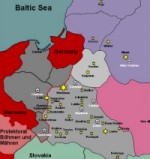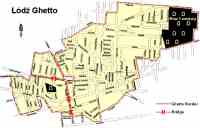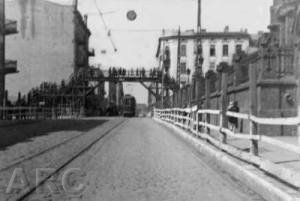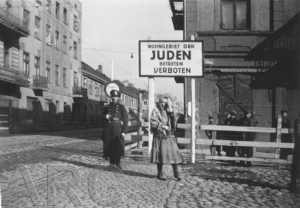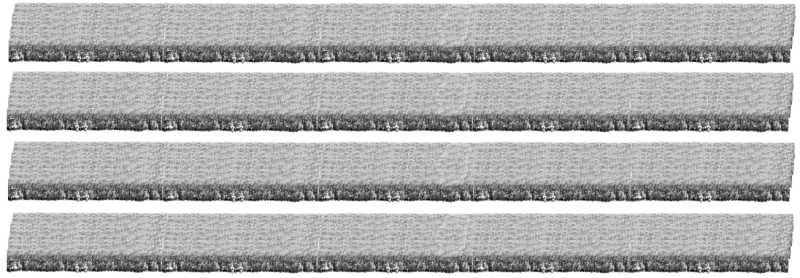Within the five months following the occupation, the Germans deported around 70,000 Jews for
work. Many Jews left the city and fled to the
. On
the
ghetto was officially opened and 164,000 remaining Jewish inhabitants were forced to move there.
.
,
supervised the ghetto and guarded the Jews. The ghetto area of four square kilometres became the
most densely populated part of Lodz.
Around 200,000 Jews (including approximately 38,500 deported Jews from Germany, Austria,
Czechoslovakia and Luxemburg) vegetated in wretched wooden houses comprising 31,271 apartments.
Living and, particularly, sanitary conditions were disastrous. Apart from the lack of food, only 725
apartments had running water, there was no sewerage, no coal or wood for heating the rooms, no warm
clothes and shoes. As a consequence, 21% of the ghetto population died in various epidemics, of starvation
or were frozen to death.
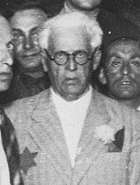 |
| Rumkowski * |
Economic plunder took place in two ways, the confiscation of Jewish property and
enforced labour in as many as 96 newly built ghetto workshops and factories, where starvation
forced the Jews to work strenuously for a piece of bread and some soup. This work as well as
all other Jewish affairs within the ghetto was managed by the
Judenrat
(Lodz:
Ältestenrat / Council of the Eldest), which was established by the
Germans in
October 1940. It was led by
Mordechai Chaim Rumkowski
(official title:
Ältester der Juden / Eldest of the Jews).
The
Judenrat managed the inadequate food rations, 5 hospitals, 47 schools, the allocation of quarters,
the Jewish Order Service and even a ghetto prison.
Because the ghettos were only intended to be temporary, the fate of the Lodz Jews
was extermination. On
16 January 1942 deportations to
Chelmno Extermination Camp
began. The
Ältestenrat was forced to select a specific number of people for each transport.
Between January and May 1942, 55,000 Jews and 5,000 Gypsies were sent to
Chelmno.
Between 5 and 12 September 1942, 12,000 Jews were deported to the same
destination. This bloody week was known as
Gehsperre (
gehen = to walk,
Sperre = block / Engl.: curfew). During the
Aktion Gehsperre
the ghetto hospital was closed. Its patients were the first to be deported, followed by nearly
all other elderly or infirm people. Children were separated from their parents and also deported.
Rumkowski prepared this deportation, which was of course based on
German orders. In his famous speech he said: "
They demand what is most dear to (the ghetto) –
children and old people."
By
September 1942, all Jews from the
Warthegau (German expression
for the annexed Western
part of Poland) had been either murdered or expelled, apart from the 77,000 Jews remaining in Lodz.
Consequently the extermination facilities in
Chelmno were closed and the
deportations from the Lodz ghetto ceased. For 19 months, until
May 1944, the
ghetto was turned into a labour
camp: 90% of the Jews worked in the ghetto factories. Older people, children and most of
the women were no longer among them.
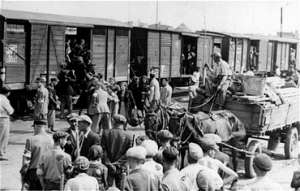 |
| Deportation to Chelmno * |
In
spring 1944 the Germans decided to liquidate the ghetto.
Chelmno was
re-established and in
early June 1944 the first transport of this second
wave left Lodz. Between that date and
15 July
7,176 Jews were sent to
Chelmno and perished there. From
7 August the new destination was
Auschwitz-Birkenau. By
30 August 1944,
approximately 67,000 Lodz Jews had been sent there.
Around 800 Jews were kept in a barrack to clean the ghetto area. Tons of the deportees'
belongings were collected and sent to Germany. In
autumn 1944, 40-60 vans left the
former ghetto every day.
These remaining workers were intended to be subsequently shot, the burial pits already having been
dug at the Jewish cemetery. Fortunately the potential victims heard about the planned executions.
They escaped and hid in the ghetto. On
19 January 1945 they were rescued by the Red Army.
The total number of survivors of the Lodz Jewish community, which in
1939
exceeded 220,000 people, has been estimated at only 5,000-7,000.
See the names of 7,168 individuals from Lodz who were transferred to the death camp at
Chelmno,
between June and August 1944 at
"Lodz Transports to the Chelmno Extermination Camp".
Sources:
Encyclopedia of the Holocaust
Photos:
USHMM
*
R. Gertz
* www.foto-onlineauktionen.de
© ARC 2005








